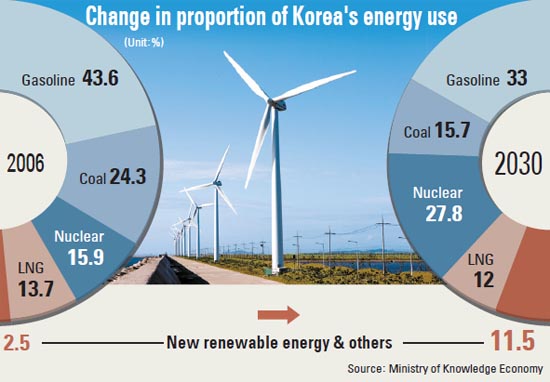Korea seeks more ways to go green

Increasing the use of renewable energy is like killing two birds with one stone. It is one way to reduce costs on importing energy and reduce greenhouse gas emissions. Furthermore, it can be a way to enhance competitiveness in a green industry that is currently rising as a promising future business.
However, there are inevitable costs to bear. In this sense, solar and wind energy - representative renewable energy sources - fall behind in terms of economic feasibility in comparison to fossil fuels or nuclear energy.
Whether Korea should increase the supply of such expensive new renewable energy or not is one question the government is mulling over as part of its energy policy in the era of high oil prices and climate change.
The government is undergoing trials and errors via diverse energy measures. A case in point is the Green Village project by the Ministry of Knowledge Economy and Korea Energy Management Corporation. The government provides subsidies to villages that are willing to install solar panels in order to cut power costs. The target is to make one million homes environmentally friendly.
Reaching ‘zero’ bills
Hwajeong Village is the nation’s first to reach the goal of reducing power bills to “zero” via solar panels. The 35 households in the village have installed solar panels on their rooftops or in their yards. Each solar panel produces 350 to 450 kilowatts of electricity a month.
Residents say their power bills were between 10,000 ($8.95) and 20,000 won, although their air-conditioners and fans were switched on all day during the summer. They give credit to the solar panels.
“I thought the latest blackout crisis was a story from another country, not one from Korea, because in Hwajeong, we generate power on our own using the solar panels,” Yoo from Hwajeong Village said.
“We used to pay between 50,000 and 60,000 won a month until last year, even in the spring and autumn,” Yoo said. “This year, we paid only 1,380 won even during the summer season when we had to keep air conditioners and fans on all day long.”
The transformation of the village has been led by young farmers in their 20s and 30s. They won approval for the green village project from the Knowledge Economy Ministry. With 600 million won in subsidies provided by the central and local governments, residents voluntarily paid from 50,000 won to 1 million won for the landmark change of their town - from relying on fossil fuels to becoming energy independent.
Hwajeong Village is the first in Korea to convert all of the households in the community into individual solar power generators.
The community center of the village has installed not only solar panels, but also a geothermal facility that converts geothermal energy into heat. About 20 community members gather every day to watch television together, use electrical appliances to make food and use electric heating pads to keep warm at the center. However, their power bills total only a third of what they used to pay when the community center used a gas boiler.
The Buan County government is willing to provide financial support for more villages to be energy independent.
“Our residents eagerly hope the county becomes energy independent. The government will spare no support for making more green villages,” Kim Ho-soo, the county mayor said.
National promotion efforts
If things go as planned, the Korean government will increase power generated by using renewable energy with a goal of reaching 7.8 percent by 2030.
“If there is no dramatic technological development in years ahead, but the government increases proportions of new renewable energy and scales back that of nuclear energy, power bills would have to rise, putting a significant burden on the economy,” KEEI Vice President Moon Young-seok said.
To increase the use of renewable energy, the ministry is also applying pressure to the business community. The ministry is contemplating a measure to require large companies that are huge consumers of electricity - Samsung Electronics, Posco and Hyundai Steel - to produce renewable energy. The point is to make those power guzzlers generate power using solar and wind energy on their own for certain amounts in proportion to their total power use.
The government also plans on increasing incentives for companies that contribute to reducing greenhouse gas emissions by using renewable energy. Part of the incentive is to double the government support for research and development (R&D) on next generation energy. Financial loans for the green growth industry will also be expanded from 6.6 trillion won last year to 10.5 trillion won next year.
By Jang Dae-suk, Song Su-hyun [ssh@joongang.co.kr]










with the Korea JoongAng Daily
To write comments, please log in to one of the accounts.
Standards Board Policy (0/250자)